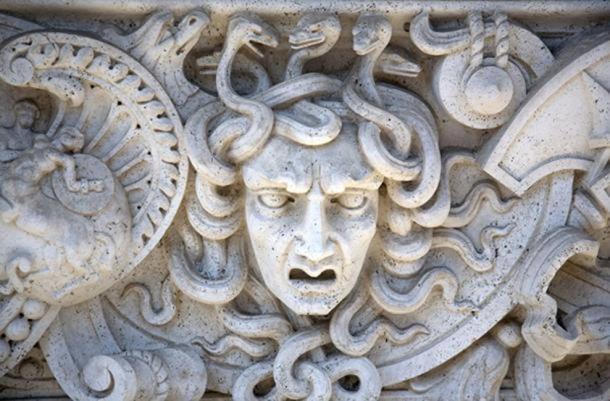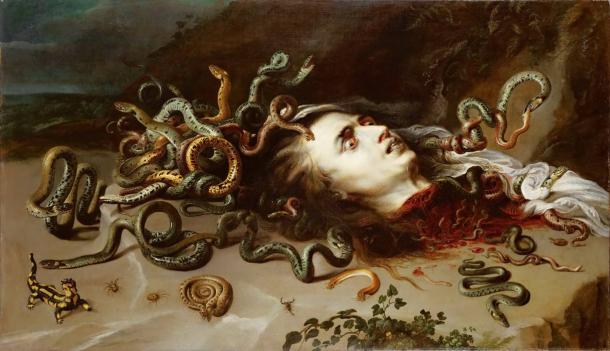In ancient Greek mythology, Medusa is the most famous of three monstrous sisters known as the Gorgons. The earliest known record about the story of Medusa and the Gorgons can be found in Hesiod’s Theogony. According to this ancient author, the three sisters, Sthenno, Euryale, and Medusa, were the children of Phorcys and Ceto and lived “beyond famed Oceanus at the world’s edge hard by Night”. Of the three, only Medusa is said to be mortal. But she is also the most famous and the myth of her demise at the hands of Perseus is often recounted.
Why Did Medusa Get Cursed?
Although Hesiod gives an account of Medusa’s origins and the death of Medusa at the hands of Perseus, he does not say more about her. By contrast, a more comprehensive account of Perseus and Medusa can be found in Ovid’s Metamorphoses. In this work, Ovid describes Medusa as originally being a beautiful maiden. Her beauty caught the eye of Poseidon, who desired her and proceeded to ravage her in Athena’s shrine. When Athena discovered the sea god had ravaged Medusa in her shrine she sought vengeance by transforming Medusa’s hair into snakes, so that anyone who gazed at her directly would be turned into stone.

Stone carved panel of the head of Medusa. ( Shelli Jensen / Adobe)
Thus, the description of Medusa changed from one of an alluring lady, as Ovid describes in Metamorphoses:
Medusa once had charms; to gain her love A rival crowd of envious lovers strove. They, who have seen her, own, they ne’er did trace More moving features in a sweeter face. Yet above all, her length of hair, they own, In golden ringlets wav’d, and graceful shone. – Ovid, Metamorphoses
- Pegasus: The Majestic White Horse of Olympus
- Ancient Greek Myth in Assassin’s Creed Odyssey: Medusa, The Minotaur and More?
- Medusa and the Gorgons: The Origins of the Legendary Tale
To a monstrous being which Virgil writes of in a far less attractive manner:
“In the middle is the Gorgon Medusa, an enormous monster about whom snaky locks twist their hissing mouths; her eyes stare malevolently, and under the base of her chin the tail-ends of serpents have tied knots.”
Some other variations of the myth suggest that Medusa and the other Gorgons were always hideous monsters and covered with snakes.
The Legend of Medusa and Perseus
The full myth of Perseus and Medusa begins years before they battled. Perseus was the son of Danae, daughter of Acrisius the King of Argos, and Zeus. The god had impregnated the princess in the form of a shower of gold after her father had locked her away upon learning from an oracle that he would be killed by his grandson. Acrisius feared the child, but wanted to avoid Zeus’ wrath, so instead of killing Perseus, he sent the baby and Danae out to sea in a wooden chest.
Dictys of the island of Seriphus rescued the two and he raised Perseus like a son. However, there were others close by who weren’t so kind to the boy. In the myth of Perseus , the hero is sent by Polydectes, Dictys’ brother and the king of Seriphus, on a quest to bring him the head of Medusa. This was a trick because Polydectes desired Perseus’ mother and wanted to get rid of her son, who was not in favor of the relationship. Such a mission would have been equivalent to suicide for Perseus and Polydectes did not expect him to ever return to Seriphus.
As Perseus was the son of Zeus, he was aided by the gods. Perseus received the Cap of Invisibility from Hades, a pair of winged sandals from Hermes, a reflective bronze shield from Athena, and a sword from Hephaestus. With these divine gifts, Perseus sought out Medusa and decapitated her with the bronze shield while she was asleep.

Head of Medusa by Peter Paul Rubens. ( Public Domain )
Immediately after the Gorgon was beheaded, the winged horse Pegasus sprung out from her neck. In the Theogony, Hesiod also mentions that the golden giant Chrysaor, who was born with a golden sword in his hand, emerged from the severed neck of Medusa. Medusa’s sisters also arrived on the scene around the same time and chased Perseus. But the hero escaped by using the Cap of Invisibility. Some versions of the myth say he took Pegasus with him as well.
After this, Perseus flew away via Hermes’ sandals or Pegasus, setting course for Seriphus. But he had several other exciting events before returning to the island. Although Perseus may be at the center of these stories, it could be argued that it is the transformative powers of Medusa’s severed head that played a pivotal role in the hero’s subsequent adventures.

Pegasus emerges from the body of Medusa. ‘The Perseus Series: The Death of Medusa I’ by Edward Burne-Jones. ( Public Domain )
The Powers of Medusa’s Head
When the blood dripped from Medusa’s head onto the plains of Libya, each drop of blood transformed into venomous serpents. The power of Medusa’s head is seen again when Perseus encountered the Titan Atlas. When Perseus asked Atlas for a place to rest for a short while, his request was refused. Knowing that he would not be able to defeat the Titan with brute force alone, he took out Medusa’s head and Atlas was turned into a mountain.
Perseus also encountered Andromeda, the daughter of the Aethiopian king Cepheus and his wife Cassiopeia. Using Medusa’s head, Perseus succeeded in rescuing the princess, who was being sacrificed to Cetus, a sea monster sent by Poseidon to punish Cassiopeia for boasting that her daughter was more beautiful than the Nereids. Medusa’s petrifying power is also used on Phineus, Andromeda’s uncle whom she was betrothed to, Proetus, the usurper of the throne of Argos, and finally Polydectes himself. Perseus’ friend Dictys took the throne and, now finished with the relic, Perseus gave Medusa’s head to Athena, who wears it on her aegis whenever she goes into battle.

Perseus Confronting Phineus with the Head of Medusa by Sebastiano Ricci. ( Public Domain )
Keeping the Medusa Myth Alive
Although Medusa is commonly regarded as a monster, her head is often seen as a protective amulet that would keep evil away. In fact, the name Medusa comes from an ancient Greek verb meaning “to guard or protect.”
- Archaeologists Unearth Marble Head of Medusa at Roman Ruins in Turkey
- Huge UK Archaeology Excavations Project Unearths Prehistoric, Roman, Anglo-Saxon, and Medieval Sites!
- Medusa, The Lake That Turns Flesh Into Stone
The image of Medusa’s head can be seen in numerous Greek and subsequent Roman artifacts such as shields, breastplates, and mosaics. One such example of a protective Medusa head pendant appeared in the form of a late 2nd to 4th century AD Roman artifact recently unearthed in the Cambridgeshire countryside . A 2,000-year-old marble head of Medusa was found not too long ago at a former Roman commercial center in Turkey as well. There are also numerous coins that bear not only the imagery of Perseus holding the head of Medusa, but also the head in its own right.

A Roman cameo of Medusa’s head from the 2nd or 3rd century. (Sailko/ CC BY SA 3.0 )
Today, the most well-known image of Medusa’s head belongs perhaps to the logo of the Italian fashion company, Versace. And let’s not forget that Medusa also made headline gaming news in the not so distant past as a tough boss battle for players in the newest game of the popular Assassin’s Creed franchise . These factors remind us that myths of the ancient world are still alive and with us in the modern world.





